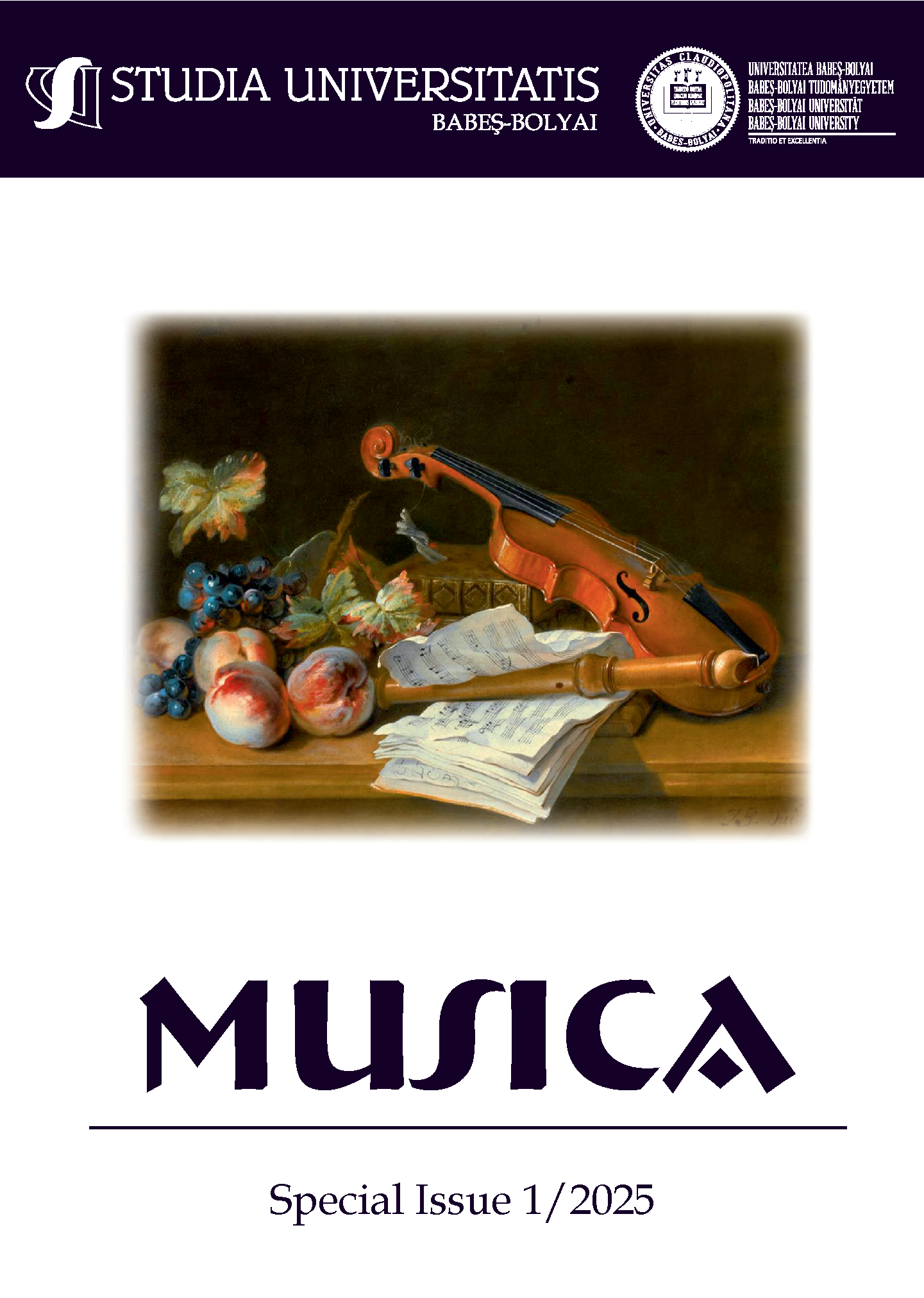ADAPTATION AND TRANSFORMATION OF MEXICAN VERNACULAR ELEMENTS IN ART MUSIC: A CASE STUDY OF MANUEL PONCE’S SONATA FOR VIOLIN AND PIANO
DOI:
https://doi.org/10.24193/subbmusica.2025.spiss1.13Keywords:
Folk-adaptation, Mexican Nationalism, StylizationAbstract
The adaptation of folk traditions into composed art music has played a crucial role in shaping national musical identities. This article explores the ways in which Mexican vernacular elements are integrated, transformed, and recontextualized within composed works, with a particular focus on the Sonata for Violin and Piano by Manuel M. Ponce. By examining the broader processes of adaptation, the authors aim to highlight how composers navigate the balance between preservation and innovation, using folk material as a foundation for new artistic expressions. The analysis addresses melodic, rhythmic, and harmonic transformation techniques, situating Ponce’s approach within a broader historical and cultural framework.
References
Aguilar, Alexandro and Roger McVey. “The Folk Influences on the Piano Works of Manuel M. Ponce.” 2023. Scholarworks Boisestate. [Accessed 8 3 2025]. <https://scholarworks.boisestate.edu/cgi/viewcontent.cgi?article=2546&context=icur#:~:text=,tap%20dance%29%20dancing>.
Antokoletz, Elliott. A History of Twentieth Century Music in a Theoretic-Analytical Context. New York and Abington: Routledge, 2014.
BIPOC Keyword Database. Huapango - Jose Pablo Moncayo. n.d. [Accessed 6 3 2025]. <https://equity.nbsymphony.org/musical-pieces/huapango#:~:text=Time%20Stamp%3A%200%3A53%20—%201%3A19,Triplet%20%20%2C%20%2017>.
Chase, Gilbert. “Creative Trends in Latin American Music-II.” Tempo 50 (1959): 25-28.
Covarrubias Ahedo, Virginia. Three Main Chamber Music Works for Strings and Piano by the Mexican Composer Manuel M. Ponce. Miami: University of Miani, 2008.
Escalante, J. Arturo Chamorr. Mariachi Antiguo, jarabe y Son: Aimbolos Compartidos y Tradicion Musical el las Identidades Jaliscienses. Jalisco: Secretaría de Cultura, Gobierno del Estado de Jalisco, 2006.
Fisk, Josiah and Jeff Nichols. Composers of music: eight centuries of writings. Boston: Northeastern University Press, 1997.
García Morillo, Roberto. Carlos Chávez: Vida y obra. Tiera Firme, mexico: Fondo de Cultura Económica, 1960.
García Morillo, Roberto. Carlos Chávez: Vida y obra. Tierra Firme: Fondo de Cultura Económica, 1960.
Gaytan, Luis Francisco. An introduction to the piano music of Manuel M. Ponce. LSU Doctoral Dissertations, 2014.
Hall, Graham F. “The Folia. Manuel Ponce and his Variations.” 1998. [Accessed 2 3 2025]. <https://api.research-repository.uwa.edu.au/ws/portalfiles/portal/43117104/Hall_Graham_1998_compressed.pdf>.
Heninger, Barbara. “El Salon Mexico.” [Accessed 1 4 2001]. Redwood Symphony. 7 3 2025. <https://redwoodsymphony.org/piece/el-salon-mexico/#:~:text=In%20creating%20his%20potpourri%2C%20Copland,response%20constructions>.
Hiley, David and Thomas E. Stanford. “Sesquialtera.” The New Grove dictionary of music and musicians. Ed. Stanley Sadie. 6th Edition. Vol. 17. London: Macmillan Publishers, 1980. 20 vols. 192-193.
Huston Symphony. A Salute to Mexico’s Independence. 7 9 2010. [Accessed 8 3 2025]. <https://houstonsymphony.org/a-salute-to-mexicos-independence/#:~:text=the%20strength%20and%20durability%20of,folk%20music%20itself>.
Kahn, Joseph and Elizabeth Kahn. “Espiritu Latino.” n.d. Austin Symphony. [Accessed 7 3 2025]. Program-Notes-MW1.pdf
LAPhil. Huapango - José Pablo MONCAYO. n.d. [Accesed 6 3 2025]. Huapango, José Pablo Moncayo
Nutt, Katharine Ferris. “Carlos Chávez: Exponent of Nationalism.” 1948. 7 3 2025. <https://digitalrepository.unm.edu/cgi/viewcontent.cgi?article=1198&context=hist_etds>.
Orbon, Julian. “Carlos Chavez’s Symphonies.” Carlos Chavez and his World. Ed. Leonora Saavedra. Princeton and Oxford: Princeton University Press, 2015. 62-76.
Orbón, Julián. “Las sinfonías de Carlos Chávez (part 2).” Pauta: Cuadernos de teoría y crítica musical 6.22 (1987b): 81-91.
Ortiz, Edward. “Exploring the enduring influence of composer Silvestre Revueltas.” 9 10 2023. Chicago Symphony Orchestra. [Accessed 5 3 2025]. <https://cso.org/experience/article/15601/exploring-the-enduring-influence-of-composer#:~:text=Think%20Afro>.
Plesch, Melanie. “Resisting the Malambo: On the Musical Topic in the Works of Alberto Ginastera.” The Musical Quarterly, 101.2/3 (2018): 157-215.
Serres, Jean-Michael. Notes on Manuel Ponce (1882–1948) and His Works. 14 2 2025. [Accessed 8 3 2025]. <https://www.jeanmichelserres.com/2025/02/14/notes-on-manuel-ponce-and-his-works/#gsc.tab=0>.
Tonatiuh, García Jiménez. Between Assimilation and Resistance of Western Musical Culture: Traces of Nationalism on José Pablo Moncayo’s Viola Sonata. Lubbock, Texas: Texas Tech University, 2014.
Vazquez Medrano, Oscar. The Romantic Style in the Piano Works of Manuel M. Ponce The Romantic Style in the Piano Works of Manuel M. Ponce. University of Nebraska-Lincoln, 2022.
Vazquez Medrano, Oscar. The Romantic Style in the Piano Works of Manuel M. Ponce. 2022. <https://digitalcommons.unl.edu/cgi/viewcontent.cgi?article=1172&context=musicstudent>.
Witten, David. The Eclectic Piano Music of Manuel M. Ponce. n.d. [Accessed 8 3 2025]. <https://www.naxos.com/MainSite/BlurbsReviews/?itemcode=8.223609&catnum=223609&filetype=AboutThisRecording&language=English>.
Zambrano, Helga. “Reimagining the Poetic and Musical Translation of “Sensemayá”.” Ethnomusicology Review 19 (2014).
Downloads
Published
How to Cite
Issue
Section
License
Copyright (c) 2025 Studia Universitatis Babeş-Bolyai Musica

This work is licensed under a Creative Commons Attribution-NonCommercial-NoDerivatives 4.0 International License.



